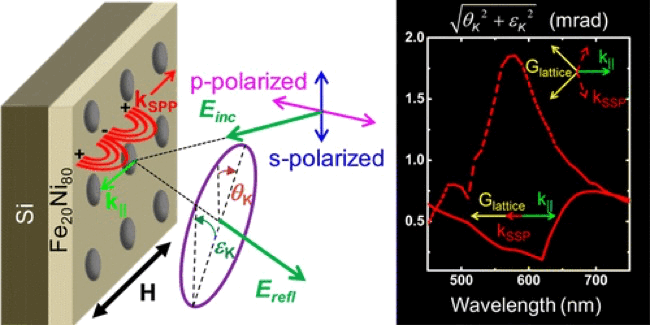Longitudinal MOKE in a 2D magneto-plasmonic crystal
03/11/15 15:42
Magnetoplasmonic crystals are spatially periodic nanostructured magnetic surfaces combining the features of surface plasmon polariton excitation and magneto-optical tunability. Here we present a comprehensive experimental and theoretical work demonstrating that in magnetoplasmonic crystals the coupling of free space radiation to surface plasmon polariton modes in conjunction with the inherent magneto-optical activity, enable cross-coupling of propagating Surface plasmon polariton modes. We have explored the consequences of this unique magnetoplasmonic crystal optical feature by studying the light reflected from a two-dimensional periodic array of cylindrical holes in a ferromagnetic layer illuminated at oblique incidence and magnetized in the sample plane, namely, in the so-called longitudinal Kerr effect geometry. We observe that the magneto-optical spectral response arises from all the excitable surface plasmon polariton modes in the magnetoplasmonic crystal irrespective of the incoming light polarization. We show that this is a direct consequence of the magneto-optically mediated coupling of propagating surface plasmon polariton modes. We demonstrate that a large enhancement of the longitudinal Kerr effect is induced when special noncollinear surface plasmon polariton modes, which couple to both p- and s-polarized light, are resonantly excited. We show how the resonant enhancement of the Kerr effect can be set at desired radiation wavelengths and incidence angles by precise plasmonic band engineering achievable through the proper design of the magnetoplasmonic lattice structure. Our findings, besides clarifying the underlying physics that governs the peculiar magneto-optical properties of magnetoplasmonic crystals, open a path to the design of novel active metamaterials with tailored and enhanced magneto-optical activity.


